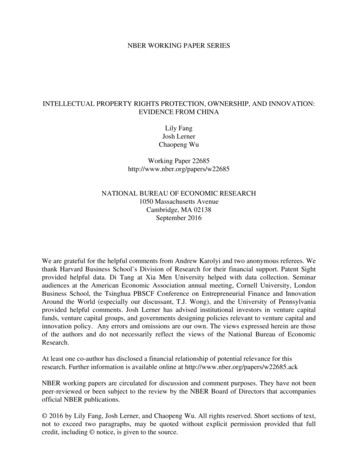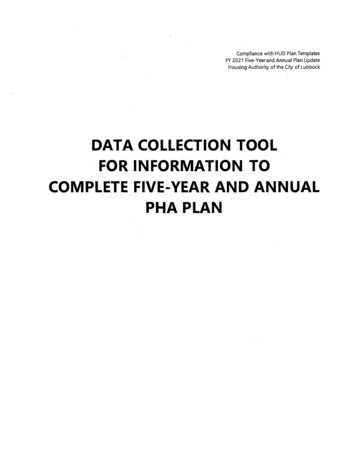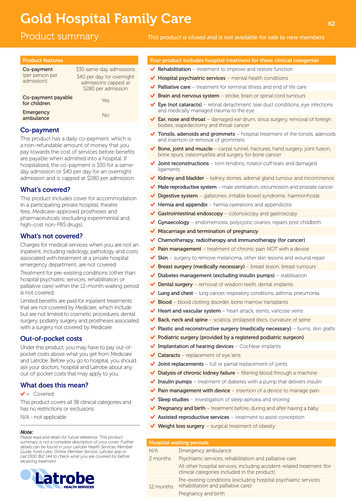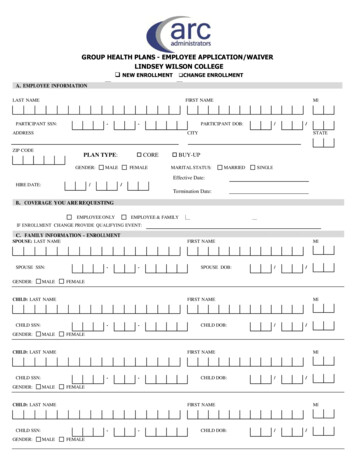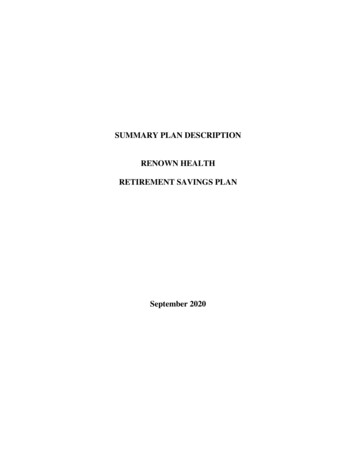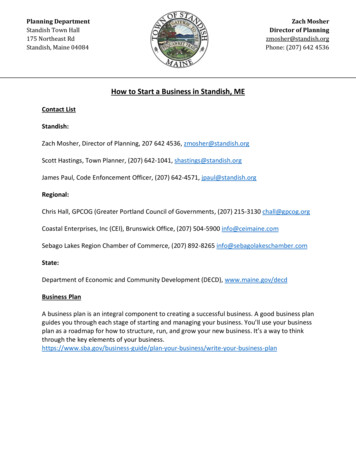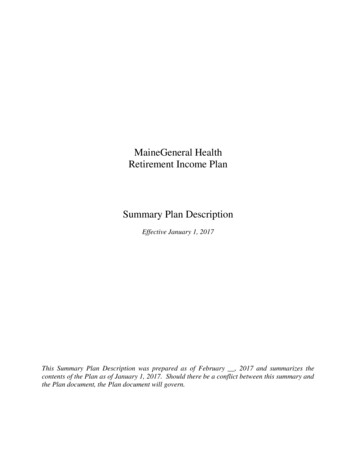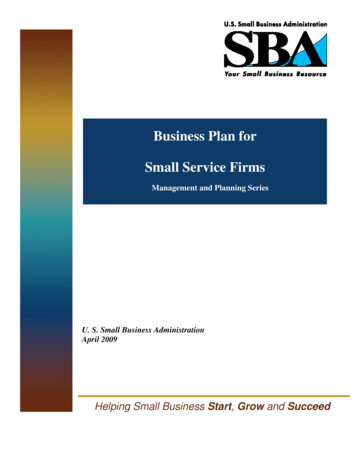
Transcription
Strategic PlanTHE OHIO STATE UNIVERSITY AT NEWARK2017 – 2020
THE OHIO STATE UNIVERSITYStrategic Planning at The Ohio State UniversitySupporting Faculty, Students, and the Structures that Foster their SuccessOhio State’s future will be defined and driven by an unwavering commitment to our faculty, students and the structures—physical, administrative, curricular, and financial—that will foster their success. Such a commitment is founded in theoverarching principles of the institution’s vision, mission, values, and core goals.VISIONThe Ohio State University is the model 21st-century public, land grant, research, urban, community engaged institution.MISSIONThe University is dedicated to: Creating and discovering knowledge to improve the well-being of our state, regional, national and global communities; Educating students through a comprehensive array of distinguished academic programs; Preparing a diverse student body to be leaders and engaged citizens; Fostering a culture of engagement and service.We understand that diversity and inclusion are essential components of our excellence.VALUESShared values are the commitments made by the University community in how we conduct our work. At The Ohio StateUniversity we value: Excellence Diversity in people and of ideas Inclusion Access and affordability Innovation Collaboration and multidisciplinary endeavor Integrity, transparency, and trustCORE GOALSFour institution-wide goals are fundamental to the University’s vision, mission and future success:Teaching and Learning: to provide an unsurpassed, student-centered learning experience led by engaged world-classfaculty and staff, and enhanced by a globally diverse student body.Research and Innovation: to create distinctive and internationally recognized contributions to the advancement offundamental knowledge and scholarship and toward solutions of the world’s most pressing problems.Outreach and Engagement: to advance a culture of engagement and collaboration involving the exchange of knowledgeand resources in a context of reciprocity with the citizens and institutions of Ohio, the nation, and the world.Resource Stewardship: to be an affordable public university, recognized for financial sustainability, unparalleledmanagement of human and physical resources, and operational efficiency and effectiveness.
Letter from the DeanThe founders of The Ohio State University at Newark aspired to establish a local campus in thescenic rolling hills of east central Ohio, one that would expand the access to the State’s flagshipinstitution to local citizens. The success of this vision is evident. Ohio State Newark has become OhioState’s largest regional campus and provides opportunities for students to complete some degreesentirely in Newark or to transition to the Columbus campus and finish there.While our founding vision has served us exceptionally well, Ohio State Newark is at a critical point inour history. The campus’s mission has transitioned from one of providing access to our region to oneof providing access to the entire State. Key initiatives from our most recent strategic plan have givenus momentum in advancing our new mission, but to sustain that momentum, we must identify andimplement new initiatives and solutions that will ensure continued success and address pressingchallenges.Recognizing that we can only achieve our ambitions if we work together, the campus leadershipagreed that our new our strategic plan needed to represent a shared and aspirational vision of ourcommon future. Our planning process required us to think deeply and creatively about thechallenges our campus, our society, and our world face, and to consult broadly with Ohio StateNewark's many stakeholders. The process was dynamic and transparent, and was guided by ourStrategic Planning Steering Committee and the Newark Board. Members of the community, areabusinesses and industries, alumni, K-12 representatives, parents, donors/benefactors, campuspartners, leaders from the Columbus campus, faculty, students, and staff participated in theplanning process.The process began by engaging our stakeholders in an online survey, gathering ideas and insightsabout Ohio State Newark’s challenges and opportunities. In spring, 2015, I hosted several retreatsand workshops to facilitate shared planning and decision-making. We also conducted acomprehensive environmental scan and SWOT assessment, through which we assessed data tosharpen and frame our vision and mission, identify areas of focus, and propose initial strategies. Ourprocess also incorporated work we had recently conducted to develop our Diversity and InclusionAction Plan. This comprehensive work sets the stage for our successful future and enables us tofurther engage our campus and community members, alumni, and supporters.Our plan supports The Ohio State University's mission, vision, and values, is structured around theuniversity’s four core goals of Teaching and Learning; Research, Innovation, and Creative Expression;Outreach and Engagement; and Resource Stewardship. It also aligns with President Drake’s 2020Vision commitments to access, affordability, and excellence; community engagement; and diversityand inclusion.The end result is a realistic plan that will strengthen our momentum. I am grateful to you for yourcontributions to our plan, and I am eager to begin the exciting work of reaching our goals. OhioState Newark is a remarkable campus with inquisitive students, dedicated faculty and staff, andunparalleled community support. Together, we have envisioned an even greater campus, and I lookforward to our collective fulfillment of that vision.Sincerely,
William L. MacDonaldExecutive Dean of the Regional CampusesDean and Director of The Ohio State University at Newark
Campus OverviewFaculty 54 Tenure/Tenure-track faculty 44 Full-time associated faculty 76 Ph.D.’sEnrollment Statistics* Head count: 2,476 Full-time students: 2,056 Part-time students: 420 FTE (full-time equivalent): 2,183 Newstudents: 1,439 Average class size: 24 Ohio counties represented: 68Number of students with a differentcountry of origin: 72 (29 countries) Average age: 20.63 Black or African American 12.96% American Indian/Alaskan Native0.33% Asian/Pacific Islander 4.32% Hispanic 3.35% Two or More Races 3.75% Caucasian 72.45% Unknown 2.84%Learning Support Services Office for Disability Services Testing Center Tutoring Center Mathematics Center Writer’s StudioArts & Recreation LeFevre Gallery Theatre University Chorus Recreational Sports Warner Center Game RoomTuitionAmong the lowest of Ohio public fouryear colleges. It is approximately 30%less than the tuition at Ohio State’sColumbus campus due to a statemandate and fewer student fees. A fulltime student that resides in Ohio anddoes not exceed 18 credit hrs/semestercan expect the following fees:Tuition 3,570Room & Board 3,940/semesterBooks 400/semesterVisionOur vision is to prepare every student to be an engaged citizenin a global society.MissionOur mission is to provide access to the university by extendingthe Ohio State experience throughout Ohio.About The Ohio State University at NewarkOhio State Newark was founded in 1957 in east central Ohioabout 40 miles east of Columbus and is the university’s largestregional campus. The Ohio State University is the flagshipinstitution of the University System of Ohio (USO) and ourcampus helps to fulfill Ohio State’s land-grant mission byproviding open access to students.Ohio State Newark offers a rich research heritage andacademic excellence. Small class sizes (average 24:1) andinteraction with faculty through research projects are uniquefeatures at the campus.All of Ohio State’s 200 majors can be started at Ohio StateNewark. Students can complete bachelor's degree programsin education, nursing (RN to BSN), business, English, historyand psychology. In addition, students can complete master'sdegrees in Early/Middle Childhood Education (M.Ed.) and inIntegrated Teaching and Learning (M.A.), and most of thecoursework for the master's in social work (M.S.W.).Faculty members at Ohio State Newark are involved inresearch and many work closely with students on theirresearch projects. Twenty-five students participated in the2015 Student Research Forum, submitting both proposedand completed research. One of these students placed firstat the 2015 Denman undergraduate research forum heldannually for all Ohio State students.Internships and service opportunities allow students toenhance their skills and confidence while participating withcommunity partners throughout Licking County. Educationabroad programming allows students to engage in crosscultural interactions and enjoy a rewarding educationexperience while in another country. Each year Ohio StateNewark sponsors two or three trips exclusively for Newarkcampus students. Scholarships are available to students
accepted into study abroad classes to make them more affordable.Social and academic programming for first year students includes Orientation, Convocation,Welcome Week, Buckeye Book Community, and the University Survey Class.Ohio State Newark participates in federal and state financial aid programs and offers a variety ofscholarships, as well as special awards for returning adult students.The campus offers abundant student recreation and cultural activities, with more than 30 studentorganizations and clubs at the Newark campus and access to over 1,000 student groups on theColumbus campus. Additionally, students have access to the campus’s Career Services Center,tutoring services, academic and personal counseling services, a new fully renovated gym and fitnesscenter, and the Multicultural Affairs office.Ohio State Newark shares its campus with Central Ohio Technical College (COTC). The twoinstitutions are proud of the unique, collaborative partnership that they have forged in offering anoutstanding array of educational opportunities for the central Ohio region and beyond. Thispartnership is viewed as a model for higher education in the state of Ohio. It provides students andthe community with a wealth of resources that would not otherwise be accessible.Non-Discrimination StatementThe Ohio State University at Newark does not discriminate on the basis of age, ancestry, color,disability, gender identity or expression, genetic information, HIV/AIDS status, military status,national origin, race, religion, sex, sexual orientation, protected veteran status, or any otherbasis under the law, in its activities, programs, admission, and employment. Generalinformation, questions, concerns or complaints related to these matters are to be directed tothe Title IX Coordinator, Holly Mason, Warner Center, Suite 226, Ohio State Newark/COTC,1179 University Drive, Newark, Ohio 43055-1797 (740.364.9578) or ADA/504 Coordinator,Connie Zang, at the same location.
Strategic ScanAs part of the planning process, an objective assessment of the current and anticipated external andinternal environmental factors that impact our campus was conducted. The factors identified by thescan were assessed in terms of the probability of the occurrence/continuance, magnitude of theirpotential impact on the campus, direction of their impact on the campus—positive or negative,impact on stakeholders, and comparisons to other institutions.The External EnvironmentOpportunitiesStrong community supportCommunity support is strong, as the success of the Next Generation Challenge scholarship campaignindicates. The campus might draw on that support to generate private funding to fulfill needs forprogramming and facilities.Strong partnerships within the county and regionIn 2016, Ohio State Newark received recognition from the Columbus campus for the exceptionalSTEM partnerships that the campus has developed with The Works: Ohio Center for History, Art andTechnology in downtown Newark. The campus is currently exploring a potential partnership withThe Works to build a planetarium for K-16 students in downtown Newark. Building on thesepartnerships could help us be an even greater contributor to Ohio’s workforce.The campus has great connections with The United Way of Licking County and many students andfaculty have engaged the community through Pay-It-Forward grants from the Ohio CampusCompact. The potential to build on these activities and further engage students in communitybuilding is strong.Demographics and population growthOhio State Newark enrolls the majority of its students from five Ohio counties, including Licking,Franklin, Delaware, Knox and Fairfield. The State has projected that persons in the 15-24-year-oldage category will increase in each of these counties over the period from 2015-2020. This growthshould help the campus maintain or grow its enrollment.Demographic forecasts indicate that Ohio’s population will become increasingly diverse. Thus, ourstudent population, which is already far more diverse than the population of Licking County, couldbecome even more diverse, and add to the richness of the student experience.Selective admissions policy at the Columbus campusOhio State’s highly selective admissions policy has encouraged prospective students from outsidethe region to apply to the regional campuses for their first year of studies at Ohio State. TheDean/Director of the Newark campus is working closely with targeted academic programs at theColumbus campus (engineering and others), as well as with the university’s enrollment marketingleaders to integrate the regional campuses into the overall university’s recruitment strategies. Thesechanges will help the campus sustain or increase its enrollment.
Need for a college-educated workforceReports from economists and national think tanks address the issue of the future economy and notethat it will demand a highly educated population to meet economic development and workforceneeds.ThreatsStudents’ inadequate academic preparation and limited financial resourcesOnly 14.8 percent of Licking County residents with have a bachelor’s degree, compared to 23.4percent of Franklin Country residents and 40 percent of the nation as a whole. The medianhousehold income in Licking County is 55,114 with 8.7 percent of families living below the povertylevel. Approximately 40 percent of Ohio State Newark students receive federal Pell grants, a keyindicator of low-income family demographics. In 2013-14, 54 percent of Newark students receivedsome kind of aid, whether federal, state/local, or institutional (including both grants and loans) withthe average amount of institutional aid of 2,981. Many of our students work long hours at parttime jobs as they pursue their studies. This factor must be taken into account as we schedule classesand events that are designed to engage students and support retention and graduation success.A recent analysis of federal data by the Education Advisory Board reports that the percentage ofPell-eligible students at regional public universities across the nation increased from 33 percent in2007 to 43 percent in 2012. This significant indicator suggests the students we serve will have evengreater financial need in the future.In addition, open access institutions such as Ohio State Newark serve students who are increasinglyunderprepared academically which requires a significant increase in resources to provideremediation and strong student support programs to retain students through to graduation.Public support and State funding for higher educationFollowing the last two recessions (2000 and 2008), state support for higher education across thenation has decreased and new formulae based on performance funding for higher educationfunding have been implemented by legislatures across the country. In Ohio, state share ofinstruction (SSI) is now based on performance funding that focuses on retention, course completion,and graduation.o In addition, the state of Ohio has implemented a tuition freeze during the current state budgetbiennium, and the Governor has established an Efficiency Task Force that has resulted inmandates to cut costs and redirect savings to students.o The high cost of higher education and student debt is also a concern of students and theirfamilies. Elected officials at the state and national levels are increasingly calling for moreaccountability and efficiency among the nation’s public higher education institutions.o Tuition and fees at Ohio State Newark make up approximately 55 percent of the campus’srevenue; therefore, a tuition freeze has a significant impact on the campus’s resources.Competition for students by other educational providersIncreasingly, in the interest of saving money, students and their families are exploring highereducation options at Ohio’s community colleges, other state schools, online courses, and highschool equivalency. Thus, competition for students has increased. As the production of high-schoolgraduates declines in other areas of the State, the competition is likely to become even moreintense.
Higher education researchers have identified that students are increasingly pursuing “stackablecredentials” that include community college two-year degrees, regional campuses’ associate’sdegrees, four year degrees, and various certificates, with the goal of increasing their value topotential employers, as well as lowering the current costs of their education and any future debt.Ohio State Newark provides associate’s degrees to students who may or may not continue towardtheir four-year baccalaureate degrees which assists students with their credentials while seekingemployment or additional educational opportunities.The Newark campus is also impacted by the expansion of the state’s “College Credit Plus” programfor high school students who take many of their college courses at their high schools rather than atthe university campus.The Internal EnvironmentStrengthsThe Ohio State University brandThe Newark campus benefits from the brand name of The Ohio State University and its reputationfor quality faculty, academic programs, and research while it also is known as a more affordableoption for students in the region.AffordabilityThe cost of attendance at Ohio State Newark is significantly lower than the cost of attendance at theColumbus campus, and the Newark campus offers institutional financial aid including scholarshipsand grants. Last year, Ohio State Newark awarded 550,000 in merit and need-based scholarshipswhich is critical financial support to our students, approximately 40 percent of whom are Pelleligible (an indicator of low-income family demographic). In 2016, the campus will implement SeniorCompletion Grants as part of a national pilot program of the Association of Public and Land-GrantUniversities (APLU), and approximately 1,000 returning students will receive 1,000 grants as part ofThe Ohio State University’s President’s new Affordability Grants initiative that now includes theregional campuses.Land-grant mission and the role of regional campusesIncreasingly, the land-grant mission of The Ohio State University is being highlighted by the newuniversity President and affordable access to an Ohio State degree through the regional campuseshas been identified as a critical factor in the land-grant mission of the university. Approximatelyone-third of all students who enroll at The Ohio State University campus in Columbus havetransferred to the Columbus campus from one of the university’s regional campuses, hence thecritical role that the regional campuses play in Ohio State’s long-term student recruitment andsuccess initiatives.Access to Ohio State Faculty and smaller classesStudents who attend the Ohio State Newark campus have access to tenure-track or tenured facultywho are recruited by the departments of their discipline at the Columbus campus of Ohio State. Dueto the smaller class size at Ohio State Newark, students receive more individual attention from theirfaculty, have more access to faculty, and are provided opportunities to engage in undergraduate
research and other high impact educational practices with their faculty, all of which increase studentengagement with the university and therefore increases their retention toward their degree.Student diversityOhio State Newark enrolls a diverse student body, with approximately 25 percent of our students in2015 coming from diverse racial and ethnic backgrounds, and with students representing 31countries of origin. Ohio State Newark is committed to closing the educational achievement gapamong students of underrepresented ethnic and racial groups, as well as low-income students.This year the campus developed a new Diversity and Inclusion Plan, working closely with all campusconstituents, including the institution’s Diversity and Inclusion Advisory Council. One of thepriorities of the Plan is to continue to increase the diversity of our students and increase efforts torecruit a diverse faculty to Ohio State Newark.Alumni engagementMany Ohio State Newark alumni are business and community leaders in the region and arepassionate about the campus and are willing to support students through their involvement intargeted initiatives.Partnership with Central Ohio Technical College (COTC)Ohio State Newark realizes cost saving by sharing facilities, services, and employees with COTC. Thispartnership serves as a model of efficiency for the state and nation, particularly during a time whenthe state legislature in Ohio is in the process of developing a model for efficiency at the state’s sevenco-located regional campuses and two-year colleges.Institutional financesOhio State Newark’s highly proactive budgeting process is critical in this period of state fundinguncertainty, tuition freezes, emphasis on affordability, and mandates to identify efficiencies andsavings. The campus’s revenue streams and endowments are positive, and its conservativebudgeting and low debt should keep it on a sustainable fiscal path.Campus facilities and parkingThe physical plant of The Ohio State Newark is well-maintained and the grounds are meticulouslymaintained with expansive green space and overall positive aesthetic environment. Parking isavailable at no cost to students and visitors to the campus.Housing options and student lifeThe campus’s new residence hall will increase on-campus housing opportunities for an additional120 students in the fall of 2017 for a total of 300 beds. The new residence hall will include eventspace for up to 300 students, which will increase the capacity for student life events on campus andenrich the student residence and student life experience.The renovation of Adena Hall will enhance our recreation and fitness facility and provide bothresidential and commuter students better wellness and fitness support.
Student success initiativesInitiatives to improve student success are working. They include learning communities and otherhigh impact educational practices that have been shown to increase student retention rates andgraduation rates. These practices include faculty mentoring initiatives, first year programs, and theestablishment of learning communities. Data show that over the last three years we retained firstgeneration students who participated in our Buckeye Generation Learning Community (BGLC) at ahigher rate than we retained first-generation students who did not participate in the BGLC.Furthermore, BGLC students also had higher grade point averages than did their other firstgeneration peers. The campus also established an Engineering Learning Community two years ago,and participation is strong.o In 2015, the campus hired an additional professional staff member and began participating in anational initiative to improve graduation rates among low-income students through a pilotprogram known as the Senior Completion Grant Program (an initiative of the Association ofPublic and Land-Grant Universities) that involves the development of policies and practicesrelated to financial aid, advising and other initiatives to reduce financial stress for low-incomesenior students and to support them so that they complete their degrees in their final year ofstudies.o Ohio State Newark is also engaged in a retention/advising project with the larger university aspart of a national initiative to increase student retention through the use of predictive analytics.Newark advising staff will be working with mentors at other universities at the national level tolearn about and apply best practices that have been identified to increase student retention andgraduation success.o Another initiative designed to address student retention through faculty engagement is a pilotFaculty Mentoring program that was initiated this year as part of the university’s first yearstudent experience curriculum.o In order to address the state’s call for greater efficiencies and savings, the Newark campus, aswell as all university units, will establish an Efficiencies and Savings Committee with the goal ofidentifying savings that may be reinvested in programs and services that support studentsuccess. It is anticipated that Ohio State Newark will be required by the university to identifyapproximately 1.3 million in efficiencies and savings over the next four-to-five years.WeaknessesHousing optionsAlthough the campus will open a new residence hall in the fall of 2017 that will increase our campushousing capacity to 300 students from 180 students currently housed, the demand from studentswho desire a residential campus experience continues to increase.Engagement of commuter studentsAs a commuter campus, there are challenges in engaging commuter students who hold jobs andhave other commitments away from campus. We know from the data that engaged students aremore likely to be retained and to complete their degree.Dining/food services optionsDining and food options on campus are limited because of a lack of customer volume.
Classroom and laboratory spaceThe campus has a master plan to address deferred maintenance and has received state capitalfunding for critical deferred maintenance projects, but there is a strong need for more classroomspace as well as laboratory space for STEM teaching and research. Much-needed renovations to thecampus’ oldest building, Founders Hall, face challenges due to lack of swing space.Curricular offerings and degree programsOhio State Newark is limited in the number of degree programs that may be completed at theregional campus, as well as course offerings toward the four-year degree, resulting in many placebound (and other) students who might prefer to remain on the Newark campus needing to transferto the Columbus campus in order to complete their degree in many majors.Regional campus as “second choice”—a perception held by some students and familiesThe dean/director of the Newark campus is working closely with the university’s senior leadership inthe areas of marketing and communications to integrate the regional campuses into the overalluniversity’s recruitment strategy in a positive and pro-active way in order to communicate thestrengths of attending Ohio State at one of the regional campuses.Student success—retention and graduationIn 2014-15, Ohio State Newark had an overall graduation rate of 37 percent over six years and 40percent over eight years; as well as an overall retention rate of 63 percent for full-time students. Thegraduation rate was lower for African American students (32 percent) and Hispanic/Latino students(23 percent).To maximize its opportunities and strengths and address the challenges discussed above, the campushas identified four primary areas of focus (to be discussed in detail in the following section). Throughinitiatives that will further develop the Student Experience, tailor Academic Programming, furtherOhio State University’s land-grant mission through a focus on Access and Affordability, and improvethe quality of life for our communities through Community Connections, the potential to change thelandscape of Ohio State Newark for future generations is before us.
Succeeding in Our Strategic Focus AreasTHE STUDENT EXPERIENCE:The Ohio State University at Newark offers students an opportunity to experience Ohio State on asmall campus with an incredibly diverse student population. We plan to leverage our diversity andthe personalized nature of our learning environment to enhance student success and furtherdistinguish the student experience. Our goal is to develop an experience that is extremely attractiveto all Ohioans because of its outstanding reputation for excellent faculty and staff who arededicated to preparing students to be engaged citizens in a global society.Strategies and initiatives:Elevate the quality of campus life (aligns with the university’s Teaching and Learning goal)- Open a new residence hall- Add additional food options; better serve the diverse culinary tastes and dietary needs ofour students- Totally renovate Founders Hall- Open a new recreational facility- Construct a science building- Improve the degree to which art on campus reflects the spectrum of human diversity,especially with respect to race and ethnicity and gender- Expand and enhance Wireless Network services for the campus communityRecruit and retain a diverse faculty (aligns with the university’s Resource Stewardship goal)- Revise the Faculty Well-Being Committee’s guidelines for mentoring to include a plan forretaining faculty who are women or underrepresented minorities.- Provide implicit-bias training for all faculty and ensure that all members of faculty searchcommittees receive training before their searches commence.Enhance student support (aligns with the university’s Teaching and Learning goal)- Enhance the cultural responsiveness of our pedagogies- Implement proactive advising and study session/events- Expand learning communities for both residential and commuting students- Increase peer mentoring and supplementa
Ohio State Newark participates in federal and state financial aid programs and offers a variety of scholarships, as well as special awards for returning adult students. . Warner Center, Suite 226, Ohio State Newark/COTC, 1179 University Drive, Newark, Ohio 43055-1797 (740.364.9578) or ADA/504 Coordinator, Connie Zang, at the same location .

